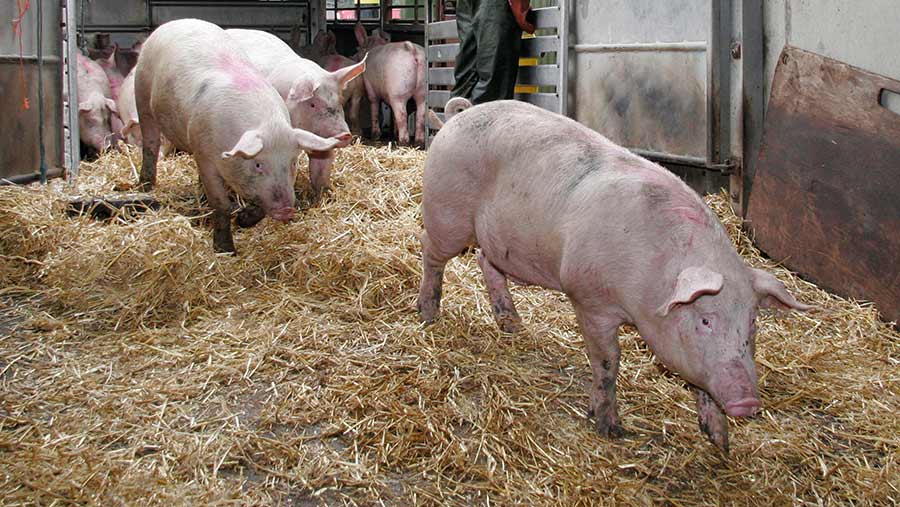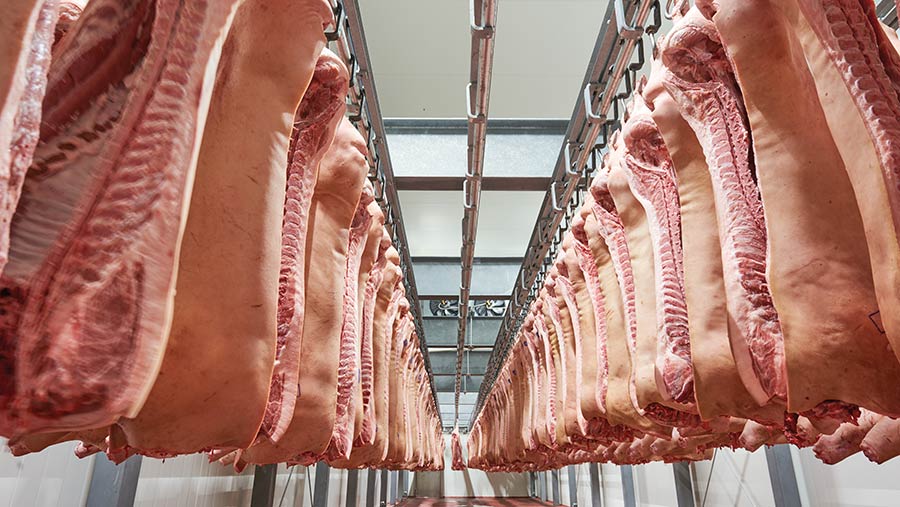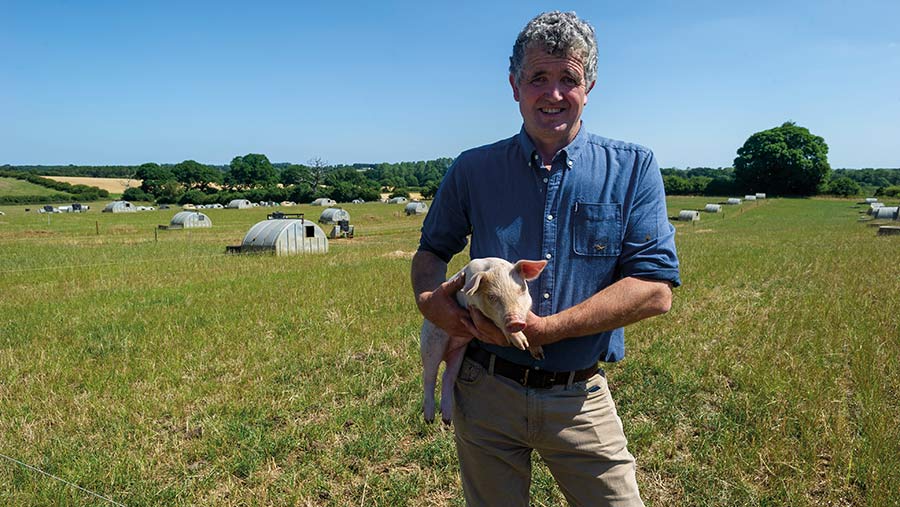Why maintaining pig slaughter capacity is vital to industry future
 © Tim Scrivener
© Tim Scrivener To describe pig producers as resilient would be an understatement after two years of trade disruption and input price hikes which have forced businesses into loss-making positions.
Many have stuck with it, though. The latest Defra headcount puts breeding sow numbers at 261,000.
But the figure is down 17% on the year, from 313,000, and that lower throughput is putting pressure on abattoirs.
See also: Rising input costs farmers’ toughest challenge for 2023
Independent pig consultant Stephen Hall says protecting and sustaining current operational slaughtering capacity must be a priority for 2023.
“The AHDB commitment to marketing and export is meaningless to UK pig producers if the slaughtering capacity is to decline,” he says.
Mr Hall worries that “doom-laden” predictions on the level of cuts in production have fed into the threat to capacity.
“If we lose slaughtering capacity we are on a very dangerous and slippery slope,” he warns.
“We need to take the bull by the horns in 2023 and hammer the government on taking food security seriously.”
Increased efficiency
With the squeeze on profits, most herds reduced their breeding populations in 2022 by culling older sows to address issues of inefficient herd structure.
Several producers ceased production altogether, but the net result is increased efficiencies in production.
Rebecca Veale, chief policy adviser at the National Pig Association (NPA), says herds in general have never been as productive.
“Nothing concentrates the mind more than losing money and, because pig farmers are good at benchmarking, monitoring where they sit, we know that they are more nimble than they have ever been.”
The Genetic Technology (Precision Breeding) bill, which seeks to make it easier to use gene-edited animals in food production, will drive further efficiencies and innovation in the pig sector.
For example, scientists at the Roslin Institute in Edinburgh have successfully implemented gene-editing techniques to produce pigs resistant to all strains of the porcine reproductive and respiratory syndrome virus (PRRSV).
Pork products from PRRSV-resistant pigs could be available to consumers as early as 2026.
High input costs
Meanwhile, after a strong year, 2022 ended with pig prices dropping below £2/kg; those, and persistently high input costs, are starting to bite.
“Some producers are making a bit of money, some will be breaking even, but others are suffering losses and that is just not sustainable,” says Ms Veale.
“Costs are showing no signs of coming down. Energy is a substantial cost for indoor herds and, although on feed we have seen an easing of the wheat price, a lot of producers have forward-bought, so they are still paying the higher prices.”
Pressure on the cost of living is unlikely to ease either, but, as pork and pigmeat products are seen as cheaper alternatives to beef and lamb, the impact on their sales may not be as significant.
Ms Veale says that, in general, UK consumers make their food choices based on price and, when times are hard, they will trade down.
Although that might mean consumers opt for pork instead of more expensive meats, in recent months there have been shifts away from premium pork cuts to cheaper alternatives such as pork mince.

© Kadmy/Adobe Stock
Impact of EU pork price
Retail prices are inching up too as a result of more expensive imports; the pig price in Germany is increasing as a consequence of contraction in its own national herd and, on the back of that, the Polish price is also going up.
That situation is helpful for the UK industry as it makes EU pork less appealing to retailers, but this is still cheaper than domestic output.
“There is a lot of excess pigmeat in the EU and we will have to wait to see how that plays out,” says Ms Veale.
A shortening of supply is expected in the spring as the large volume that had been put in storage diminishes, and that could also help the UK pig price.
System change
Mr Hall predicts the collapse, and the subsequent evolution, of the current pig pricing mechanism.
This is because corporately owned vertical integration has effectively lowered the pig price for independent producers, whose margin is taken on carcass only, he says.
“It has also resulted in a lowering of the contract pig price relative to the cost of production. So change is needed.”
“The principle of fair trade in retail promotion is now fundamentally applicable to British agricultural production.”
Policy changes could emerge, too, once Defra publishes its summary of responses to the supply chain fairness consultation.
Contractual practices remain a huge issue for producers, says Ms Veale, as they presently shoulder a “disproportionate” risk.
“We are not expecting to see any policy changes in 2023 as a result of that consultation because it will take time to get right, but there is a will in Defra to address the issues with contracts,” she says.
UK pig production could see further consolidation of corporate integration through an increased share of owned production.
To supplement the integrated business model, Mr Hall anticipates increased imports of cheaper, less regulated pig meat.
This is because ever-shortening supply and demand cycles without any price support will erode output from independent production, he says.
Case study: Rob McGregor, LSB Pigs, Norfolk
Farm facts: Herd performance at LSB Pigs, Norfolk
- 27.3 pigs reared a sow a year
- 14.1 pigs born alive a litter
- 12.2 pigs weaned a litter
- 2.23 litters a year

Rob McGregor © Jason Bye
While confidence is generally low among pig farmers, Rob McGregor, a contract producer with an outdoor system, is less exposed to current risks than independent breeders.
He runs 1,500 sows in two outdoor herds in Norfolk, producing weaners under a contract agreement for processor Pilgrim’s Pride.
Pilgrim’s Pride owns the breeding stock and supplies feed and veterinary care, and Mr McGregor’s employer, LSB Pigs, provides the equipment, labour and land. He is employed by the partnership as the overall production manager.
Protection from highs and lows
This model, he says, means he is protected from the low pig price and high-input cost pressures being heaped on independent producers.
“It allows us to work out our costs, budget and make predictions for the months ahead,” he says.
“Pig producers need to be able to invest and to budget forward because businesses that are constantly on the back foot can quite quickly become run down.”
The business operates on 65ha (161 acres) rented from a large estate within a six-to-eight-year arable rotation.
Sows are White Landrace cross Duroc and farrowing takes place every two weeks in each of the two herds. Most of the breeding is done with AI, with boars used to sweep up and encourage sows into heat.
Mr McGregor has been pig farming for 35 years and still believes it is an industry with a future, for him and his nine staff, but he anticipates that the next couple of years could be tricky.
“We are surrounded by a lot of independent producers and many of those are questioning if they are able to carry on because they are just not making any money,” he says.

